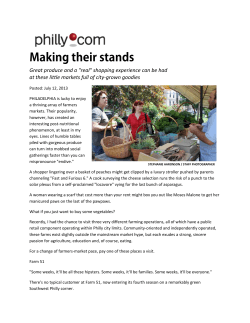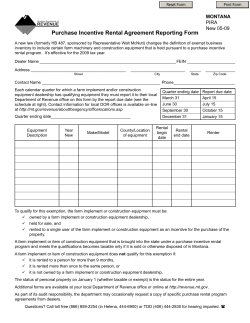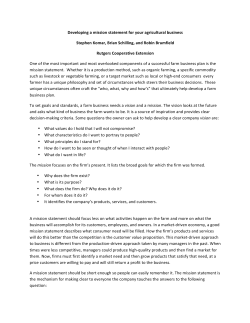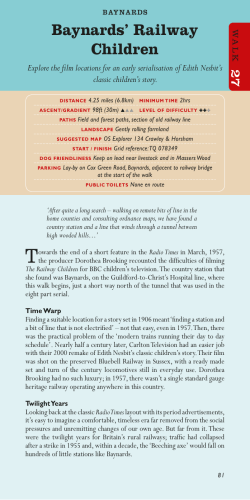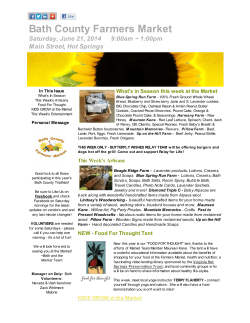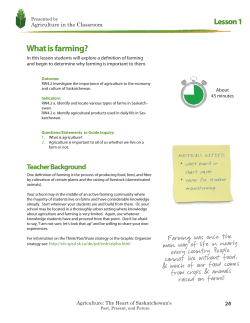
IN PURSUIT OF SUSTAINABILITY: THE USE OF THE BUSINESS Abstract
IFMA19 Theme: 19th International Farm Management Congress, SGGW, Warsaw, Poland Risk & Sustain G.G. DUCASSE, K.M. HURLY IN PURSUIT OF SUSTAINABILITY: THE USE OF THE BUSINESS PLAN AS A MANAGEMENT TOOL FOR GROWERS G.G. Ducasse, K.M. Hurly CANEGROWERS, P.O. Box 888, Mount Edgecombe, 4300, KwaZulu-Natal, South Africa Abstract The Sustainable Sugarcane Farm Management System SUSFARMS® proposes that for the “Prosperity” pillar to be upheld, both a detailed agronomic and financial plan need to be put in place. This can be achieved through the development of a comprehensive business plan which provides an assessment of the farm business intervention requirements in order to develop the farming enterprise which include: crop establishment, infrastructure development, mentoring, capacity building, and other assistance in the daily operations of the business. This re-establishment of the farm economic infrastructure is essential to provide a base for sustained profitability. The paper stresses the important role of the entrepreneur who has to take responsibility for the plan and treat it like a living document which can, with assistance of skilled agronomic and economic extension staff, be used as an invaluable management tool to guide decisions on various aspects of the farming business. Keywords: sustainability, business plan, management tool, land reform 1. Introduction The concept of sustainability in the agricultural setting has gained significant momentum over the past decade. There is a growing recognition that if on-farm production is to be sustained, and indeed enhanced, into the future, three interrelated goals need to be pursued concurrently, namely; environmental health, economic viability, and social and economic equity. The South African sugarcane industry is no different and it is upon this premise that SuSFarMS, The Sustainable Sugarcane Farm Management System, is built (Maher, 2007; Sustainable Sugar Initiative, 2008). The system is designed to encourage sustainable sugarcane production through the implementation of better management practices (BMPs), which reduce the negative impacts on the environment whilst ensuring economic sustainability and social upliftment. The system is built upon three pillars, namely; (i) Prosperity (economic principle) – economically viable sugarcane productions is maintained or enhanced; (ii) People (social principle) – the rights of employees and local community are upheld and promoted; and (iii) Planet (environmental principle) – natural assets are conserved, critical ecosystems services are maintained and agricultural resources are sustainably used. This paper focuses on the first of these three pillars, the principle of prosperity, which aims at enhancing economically viable sugarcane production. This is achieved, in part, through the development of an annual production plan (agronomics) and an annual financial plan (economics). Thus an optimum balance between agronomics and economics is sought in order to maintain or enhance production. 2. Land reform in the South African sugar industry In 1994, the ANC led Government introduced a land and agrarian reform programme to redress the injustices and legacies inherited in the land and agrarian sectors under the apartheid regime (marked by widespread dispossession, and rural poverty), and, by redistributing land to black South Africans, to transform the structural basis of racial inequality (Hall, 2004; Thomson and Gillitt, 2007). The land Vol.2. July 2013 - ISBN 978-92-990062-2-1 - www.ifmaonline.org - Congress Proceedings 1 IFMA19 Theme: 19th International Farm Management Congress, SGGW, Warsaw, Poland Risk & Sustain IN PURSUIT OF SUSTAINABILITY: THE USE OF THE BUSINESS PLAN AS A MANAGEMENT... reform programme is implemented in two key forms, namely; (i) land redistribution – whereby land is transferred through the pro-market willing seller-willing buyer principle (a completely voluntary transaction between a buyer and a seller), and (ii) land restitution – whereby land is returned to people who were dispossessed post-1913, which marks the year of the first Land Act, which legalised land dispossession on a large scale. This has created a new class of black commercial new-entrant farmers. Given their unfortunate history, these beneficiaries often lack knowledge and expertise in both managing the agronomic and financial aspects of the business, making them sensitive to even the smallest economic shocks (DAFF, 2011). Given their apparent vulnerability, this paper uses land reform growers as a case study to explore the usefulness of a business plan as a management tool aimed at promoting sustainable agricultural businesses – with specific reference to the South African sugar cane industry. A fundamental element of land reform is sufficient support to assist the new land owners to become productive users of such land. This comes in the form of post-settlement support which may involve provision of finance, farming inputs, information and training, etc. Recently (2011) the South African government, through the Department of Rural Development and Land Reform (DRDLR), has showed a strong commitment to the sustainability of farms transferred to land reform beneficiaries since 1994 with the introduction of the Recapitalisation and Development Programme (RADP). Due to lack of working capital, capital equipment, management skills and institutional support amongst other factors, there been significant decline in yields post transfer on many of these farms. This program is aimed at revitalising these “distressed” farms and, vitally, aims to ensure that the farming businesses remain self-sustainable into the future. The sugar industry is participating in the RADP Programme by acting as Strategic Partners or Mentors (generally performed by the various milling companies), and by providing project management and technical support at no cost to the beneficiary. Arguably one of the most important components of the industry support has been the commitment of resources to the process of business plan development – essential if the programme is going to be successful in the long-term. CANEGROWERS as the economic advisors to growers’, has undertaken this activity. 3. The business plan It is important from the outset to clearly define what a business plan represents and its purpose. DAFF (2011, p. 2) defines a business plan as a “plan of how a business owner, manager or entrepreneur intends to organise an entrepreneurial endeavour and implement activities necessary and sufficient for the venture to succeed”. Key to this definition is the fact that ownership of the business plan lies with the entrepreneur. Experience has shown that as soon as a business plan is viewed simply as a gateway to access government funding, the real value of the document is lost, destined to be shelved the moment funds are approved. Rather, a business plan should be viewed as an essential tool for planning, direction and running a business. Indeed, the document clarifies the operational and financial objectives of a business and contains the detailed plans and budgets showing how the objectives are to be realised, resulting in a profitable and sustainable business. Accordingly, the purpose of the business plan is to quantify all the required interventions to make the farming business profitable, and to plan how these interventions will be budgeted for in the next five to ten years. The reason for preparing a business plan varies according to the needs to be addressed at a certain point in time. Accordingly, a business plan may be internally or externally focused. An internally focused business plan will talk to the business intermediate goals required to reach the external goals, while an externally focused business plan seeks to convince an external funder (government or financial institutions) that the business has the means to ensure that it is profitable and sustainable and able to make repayments (if applicable). Indeed, in regard to RADP, a Vol.2. July 2013 - ISBN 978-92-990062-2-1 - www.ifmaonline.org - Congress Proceedings 2 IFMA19 Theme: 19th International Farm Management Congress, SGGW, Warsaw, Poland Risk & Sustain G.G. DUCASSE, K.M. HURLY credible and bankable business plan which defines a path to reach sustained profitability of the enterprise is a prerequisite for access to funding. 4. Sustainability requires people, planet and prosperity be addressed In the sugarcane industry, the business plan development process has been led by CANEGROWERS given that its expertise lies in the economics of sugar cane production. However, a business plan, by its very nature, requires a multidisciplinary approach. Particularly in the land reform context, the focus cannot not lay solely on enhancing yields and grower returns, but must concurrently address institutional arrangements, social challenges, organisational arrangements and farm business management and related training requirements to ensure long-term sustainability. To achieve this, CANEGROWERS regional staff collaborate closely with their counterparts in SASRI (agronomic specialists), milling companies (extension support), and SASA (social facilitation & institutional support). Crucially, the entrepreneur is also involved in, and contributes to, the process. This not only provides a key learning opportunity for the entrepreneur, but also helps create a sense of ownership which in turn enhances that probability of successful implementation and on-going monitoring and evaluation. Having reviewed social, institutional and organisational aspects to ensure that the business is correctly placed and structured to conduct business, a forward-focused production plan needs to be developed noting interventions required to achieve this plan. Focus is typically on mediumto long-term interventions that will improve the profitability outlook of the farm business. The priorities on the farm are ascertained by key industry stakeholders including SASRI extension staff. From an agronomic stand point these generally include: • Resource assessment (physical, climate, soils, topography, historical prod.). • Cane root analysis – age disposition. • Immediate replanting needs analysis (including variety recommendation). • Assessment of infrastructure needs. • Assessment of machinery and equipment needs. This process needs to be carefully managed and “wants” and “needs” must to be clarified and priority allocated to those aspects which enhance the revenue generating and/or cost saving attributes of each farm business that are within the scope of the business requirements. Typically, priority is given to replanting of cane roots as these are the key to enhance and sustain the revenue generating capacity of the farm. A cane root disposition analysis is completed and an opinion of cane replanting requirements is obtained from a SASRI Extension (Agronomic) Specialist. The ability and capacity of the farm business resources as well as the availability of any external resources required must be considered in order to determine the extent of planting in any particular year. When considering machinery and equipment requirements, focus is on usage that will be economically sustainable at the expected farm production levels and where the management capacity on the farm will be able to efficiently manage and maintain the equipment (a SASRI Mechanisation Guideline has been developed to simplify decision making in this regard) – in absence of this capacity alternative options will be presented to the grower, such as the use of contractors. Similarly, infrastructure that directly contributes to the economic sustainability of the farm (e.g. enables better efficiencies, reduces costs or increases revenue) will be allocated funding in the financial plan. Throughout this process the entrepreneur will be involved, providing a unique opportunity for him/her to fully consider his/her management options on the farm. Key planning tools in this process should include SUSFARMS® (2012) (through the implementation of BMPs), variety disposition plan, biosecurity plan and, if grower is a new-entrant, a farming calendar to identify Vol.2. July 2013 - ISBN 978-92-990062-2-1 - www.ifmaonline.org - Congress Proceedings 3 IFMA19 Theme: 19th International Farm Management Congress, SGGW, Warsaw, Poland Risk & Sustain IN PURSUIT OF SUSTAINABILITY: THE USE OF THE BUSINESS PLAN AS A MANAGEMENT... the correct timing of various farming operations. Indeed, successful cane farming is about doing the right thing at the right time and having the funds to pay for it. Accordingly, the aforementioned planning process is then consolidated into a 5- to 10-year production plan which is the key input into the financial plan. This then integrates the three principle requirements of SUSFARMS (2012). The financial plan should, as with the other aspects of the business plan, be drawn up in close consultation with the farming representatives and every effort should be made to ensure the accuracy of the financial information. Whilst CANEGROWERS has developed a financial model template which provides the basis for the cost structure and can be used to guide the discussion, it is understood that every farm business is unique and thus customisation is to be expected in each project. Of equal importance is to ensure that all debt obligations are included in the budget. These include bonds, hire purchases and medium-term/seasonal loans – including any outstanding tax obligations. This information is important in order to assess the ability of the farm to meet all debt obligations under a normal/optimal production scenario. The cost of management and drawings must also be considered – in certain cases the owner may simply draw a management salary that covers personal needs, but in others, a manager may be hired as well as the owner taking drawings – this should be included to ensure that the farm business will cover these needs. Many growers find record-keeping an arduous task but for the many land reform farming businesses such information is often not easily available, with record keeping systems either absent entirely or incomprehensive. Indeed, in some instances bank statements are the only available guiding documents. It is vital therefore that the entrepreneur is coached on the importance of record keeping. This in turn will significantly simplify cash flow budgeting that is to be conducted on an on-going annual basis, with assistance from CANEGROWERS staff. The financial plan essentially fulfils the purpose of the business plan by quantifying all the required interventions identified to make the farming business profitable, and shows how these interventions will be budgeted for in the next five to ten years. Drawing on the resource assessment and production plan, and utilizing current cost and revenue estimates, which are largely based on a combination of data received from CANEGROWERS’ industry averages as well as in consultation with the owner/manager, a ten year cash flow projection is developed. In addition, the first five years cash flow projection is analysed in more detail to ensure that there is sufficient working capital in the early years, particularly if significant replant is required which is associated with a heavy financial burden in the in the short term – especially is case where there is limited or no grant funding available. Hence the importance of component cost functions (planting, rationing etc.) required to identify the source of any cash flow pressure. Scenario analyses may also be performed with the owner/manager showing comparisons between normal and optimum production, equipment ownership vs. use of contractor, enterprise diversification choices etc. The financial plan should be used to plan the long-term development and sustainability of the farm business. Upon completion, the detailed financial plan, as well as a summary for ease of reference, is appended to the business plan write-up. This financial plan, incorporating the production plan and associated costs of required interventions can then be presented to the implementing agent (Strategic Partner) once the business plan has been approved. Monitoring and evaluation of the implementation process then becomes of vital importance as a good plan with poor execution is as damaging as a poor plan! CANEGROWERS economic advisors are all qualified to fulfil this function. To facilitate this monitoring and evaluation, the industry has instituted Land Reform Development Committees in each of the growing regions. These committees compromise of various government departments, growers, millers and economic and agronomic extension staff; thereby Vol.2. July 2013 - ISBN 978-92-990062-2-1 - www.ifmaonline.org - Congress Proceedings 4 IFMA19 Theme: 19th International Farm Management Congress, SGGW, Warsaw, Poland Risk & Sustain G.G. DUCASSE, K.M. HURLY representing a comprehensive and diverse set of skills and experience in the sugar industry readily at its disposal. The primary aim of the Committee is to provide all stakeholders with a platform for structured and constructive communication, coordination, cooperation and information sharing concerning the effective implementation of land and agrarian reform in the region. Accordingly, the Committee is essential in the monitoring and evaluation process the various Land Reform projects, and facilitates transparency, efficiency and effectiveness of implementation plans as detailed in the respective business plans, as well as promoting developmental outcomes and longterm sustainability of the Land Reform programme. Once the farm has been redeveloped and reaches an optimal level of productivity, it is essential that best management practices are followed (such as maintaining at least a 10% annual replant programme) in order to maintain productivity. This will also require sound financial management and responsible budgeting and spending. Economic and agronomic extension is available to assistance in this regard, but it is up to the entrepreneur to take full advantage of this support. Indeed, the financial plan prepared as part of the business plan should be seen as a living document, updated in line with changes in financial position, agronomic developments and production expectations, amongst others. Updated on a regular basis, this represents an invaluable management tool, as it cuts across all aspects of the business and enables the entrepreneur to predict the impact that any particular internal or external change may have on farming business as a whole, and to adapt accordingly. 5. Conclusions The Sustainable Sugarcane Farm Management System proposes that for the “Prosperity” pillar to be upheld, both a detailed agronomic and financial plan need to be put in place. This can be achieved through the development of a comprehensive business plan which provides an assessment of the farm business intervention requirements in order to develop the farming enterprise which include: crop establishment, infrastructure development, mentoring, capacity building, and other assistance in the daily operations of the business. This re-establishment of the farm economic infrastructure is essential to provide a base for sustained profitability. The paper has stressed the importance of the entrepreneur taking ownership of his/her business plan and treating it as a living document which can, with assistance of skilled extension staff, be used as an invaluable management tool to guide decisions on various aspects of the farming business. 6. References Department of Agriculture, Forestry and Fisheries, 2011. Agricultural Business Plan Guidelines. http:// www.nda.agric.za/doaDev/AgricDevFinance/BusinessPlanGuidelines(VIS).pdf (Cited 16 March 2013). Department of Agriculture, Forestry and Fisheries (DAFF), 2011. Agricultural Business Plan Guidelines. http://www.nda.agric.za/doaDev/AgricDevFinance/BusinessPlanGuidelines(VIS).pdf (Cited 16 March 2013). Hall R., 2004. A Political economy of land reform in South Africa. Review of African Political Economy 31(100): 213-227. Maher G.W., 2007. SuSFarMS environmental management system: An extension tool for implementing better management practices in sugarcane. Proc Int Soc Sug Cane Technol 26: 498-503. SUSFARMS, 2012. Version 2. SASA Internal document. Sustainable Sugar Initiative, 2008. SuSFarMS Sustainable sugarcane farm management system. Version 1. WWF, Mondi Wetlands Project, Noodsberg Canegrowers. Thomson R., Gillitt C.G., 2007. The Land Reform Process in South Africa with emphasis on land restitution. 16th IFMA Congress, Ireland. Vol.2. July 2013 - ISBN 978-92-990062-2-1 - www.ifmaonline.org - Congress Proceedings 5
© Copyright 2025
